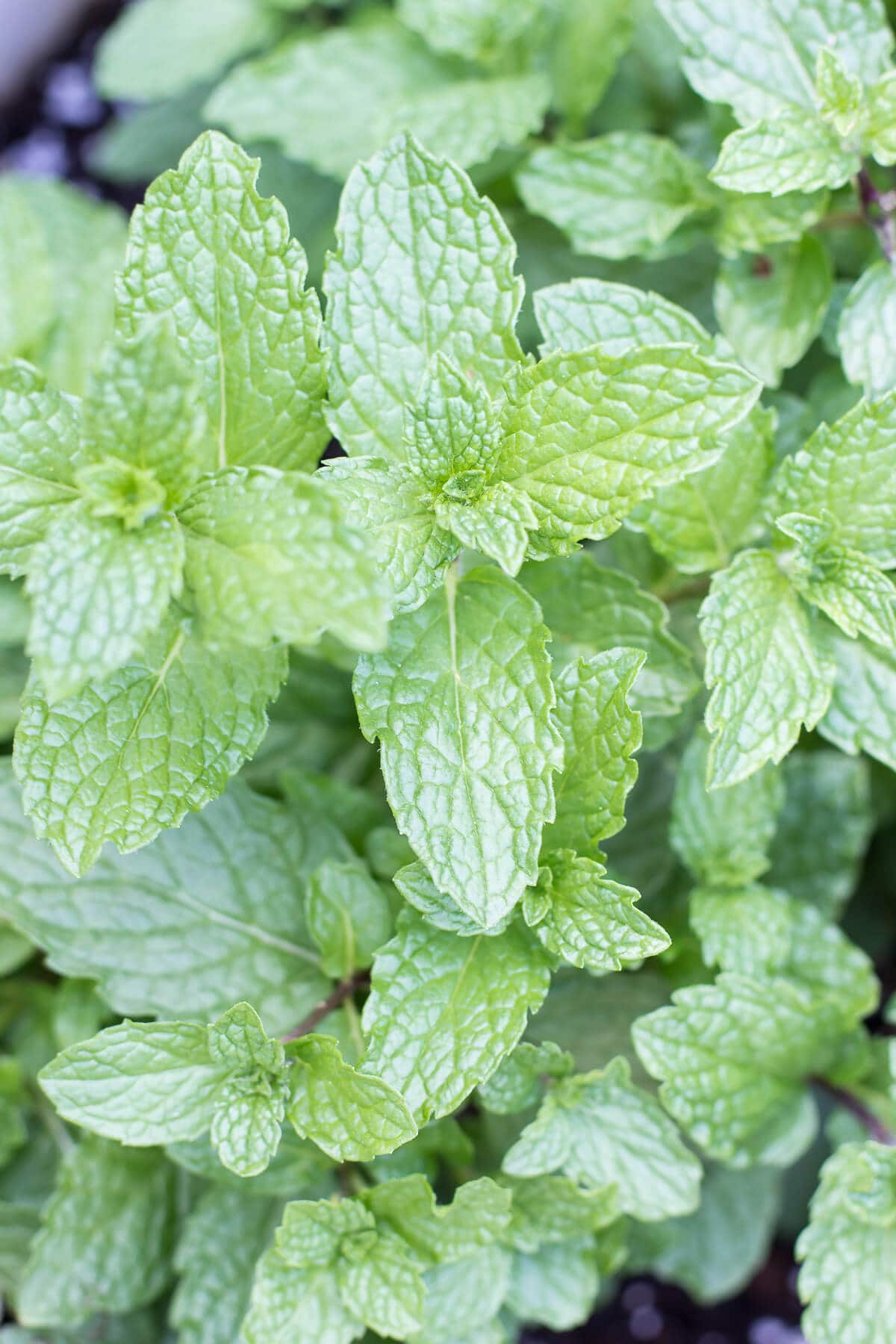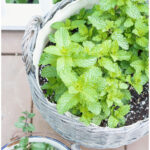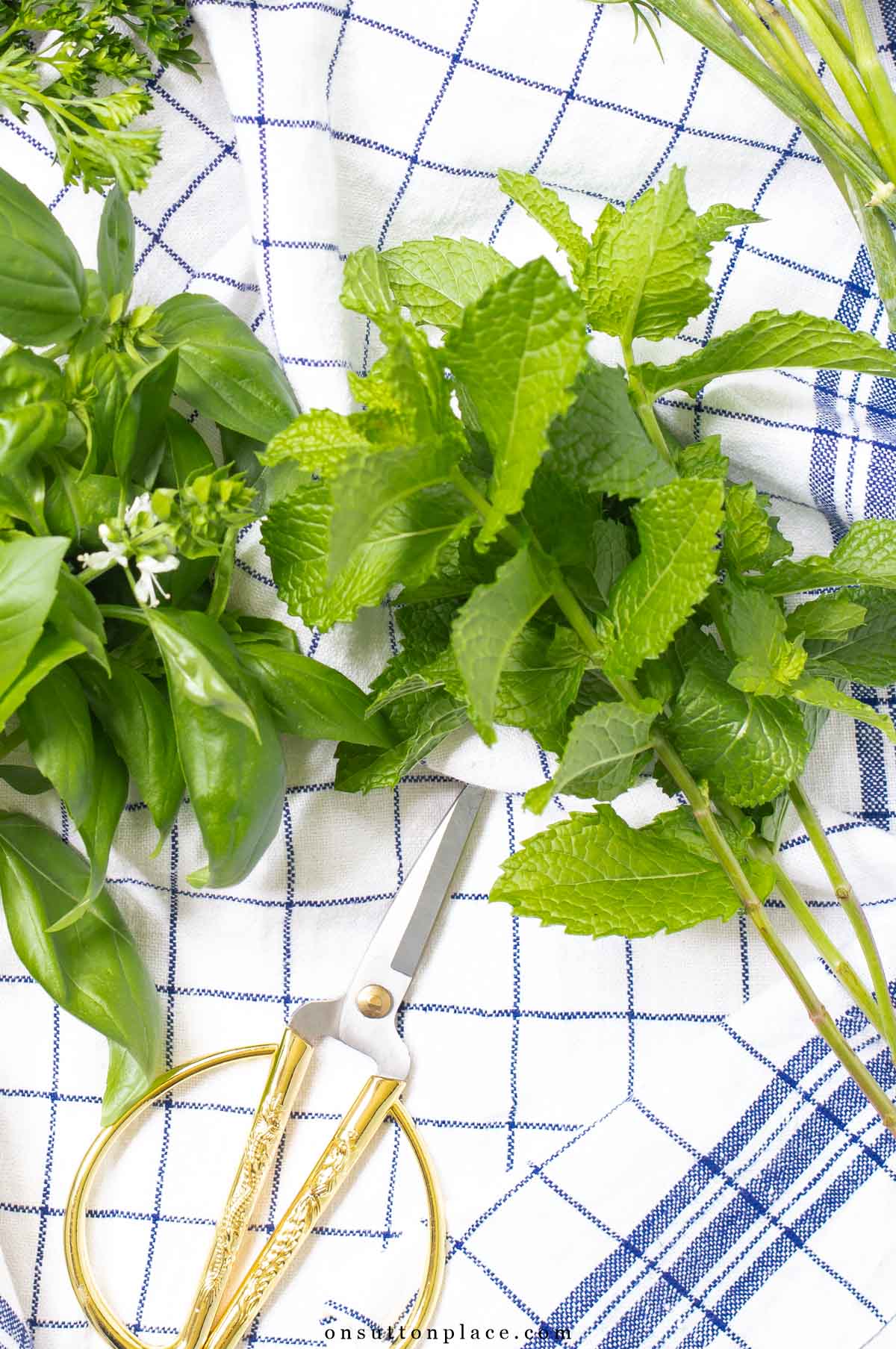This post may contain affiliate links. See my disclosure statement.
Grow a mint plant with ease. Tips for planting, caring for, and enjoying fresh mint all season long…even in small spaces.

If you’ve ever considered growing a mint plant, there’s no better time to start. Mint is incredibly easy to grow, and once it’s established, it practically takes care of itself. It’s the perfect choice for anyone who wants to add something fresh and useful to their outdoor space. Whether you want to use it in drinks, recipes, or simply enjoy its clean scent, mint is one of those plants that delivers more than expected. With just a little care, you’ll have a steady supply of leaves right outside your door.
Mint is easy to grow and flourishes in containers.
Mint is a perennial herb that sometimes gets a bad reputation for being invasive, but that’s only a concern when it’s planted directly in the ground. The good news is that mint thrives in containers, which keeps it under control and easy to manage. Just make sure your pots have good drainage, use fertile soil, and place them where they’ll receive several hours of sun each day. A scoop of compost will give the plants an extra boost. All my herbs are grown in containers, and I can’t recommend it enough. It’s convenient, tidy, and ideal for small spaces.
Mint plants can be harvested constantly.
Mint is a fast grower, which makes it one of the most rewarding herbs to keep on hand. Regular harvesting actually helps the plant stay healthy and full. Even if it’s cut back almost entirely, it will bounce back within a week or two. Mint also spreads by sending out runners. These are stems that grow out from the main plant, dip down into the soil, and root themselves to form new growth. This is helpful to understand if you’re growing mint in a container, because it’s best to remove any weak or diseased sections before they take hold. Since mint grows so quickly, it’s a wonderful herb to preserve. You can dry or freeze it to use later. Dried mint makes excellent tea, and it adds subtle flavor to casseroles or as a seasoning for lamb.

Mint can be grown in partial shade or full sun.
One of the best things about mint is its flexibility when it comes to light. It grows well in full sun, but it can also thrive in partial shade. So even if your deck or patio only gets morning sun, you can still grow healthy mint. Because it’s a perennial, mint will come back each year as long as the conditions are right. I’ve grown mint in containers for many seasons, but I only had it return on its own one time. I had placed the container in full sun, and I believe that made all the difference. Before that, my containers sat on a shaded deck. The mint still grew beautifully, but I had to replant every spring.
There is literally no maintenance, except watering.
Mint truly is one of the easiest herbs to grow. Once it’s planted, the only thing it really needs is regular watering. My method is very straightforward: I buy small mint plants and place them in containers filled with fresh, fertilized potting soil. I try to water consistently, especially during hot stretches, but I’ll admit that sometimes I forget. Even then, the mint holds on and keeps growing. If you harvest it often, there’s no need to pinch it back, which means one less thing to worry about. The only issue I’ve encountered is mint rust, a fungal disease that shows up as orange spots on the leaves. If you see it, remove the affected parts right away to keep it from spreading.

Use the mint leaves in delicious recipes.
The fresh flavor of mint adds a bright, refreshing touch to both food and drinks. It pairs especially well with fruit, vegetables, and light beverages. A few easy ideas include Watermelon Mint Salad, a Mint Lemonade Spritzer, or this delicious mint honey. Add it to a sheet pan of vegetables before roasting. It’s especially good with new potatoes, carrots, cabbage, tomatoes, green beans, fresh peas, or asparagus. For a fun and easy way to add flavor to drinks, try making mint ice cubes. Just place small mint sprigs in an ice cube tray, fill with water, and freeze. They’re perfect for lemonade, mocktails, or even a glass of iced tea.

Mint plants repel flies, moths, aphids, spider mites, and mosquitoes.
If your herb garden containers are placed on a deck or patio, the scent of the herbs, especially mint, acts as a natural bug repellent. The essential oils in mint are what give it that strong fragrance, and most insects steer clear. The more herbs you grow, the fewer pests you’re likely to see. As an added bonus, pollinators are drawn to mint. Butterflies love it, and bees aren’t picky about the variety. It’s a great way to support beneficial insects while keeping the bothersome ones away.
Mint can be grown indoors.
Even though mint grows beautifully outdoors, it can also do very well inside. Use a pot with good drainage and place it in a sunny spot, such as a windowsill that gets several hours of light each day. I like to start my herb plants in the kitchen in early spring, then move them outside once the risk of frost has passed. It’s an easy way to get a head start on the growing season, and having fresh mint right in the kitchen is a treat.

There are different types to choose from.
- Chocolate Mint
- Mojito Mint
- Spearmint (Mentha spicata)
- Peppermint (Mentha piperita)
- Apple Mint
- Pineapple mint
- Eau de Cologne Mint (Mentha x piperita citrata)
It’s beautiful as a garnish.
Mint sprigs are a simple way to make any dish or drink look more inviting. They add a fresh, pretty touch to salads, desserts, and beverages. I especially love using mint in drinks…even a glass of plain water feels a little more special with a few fresh leaves floating on top. It’s an easy detail that makes a big difference.

Use In Garden Flower Arrangements.
Because mint grows so quickly, there may be times when you have more than you can use in the kitchen. When that happens, I like to cut a bunch and include it in my garden flower arrangements. It adds a fresh touch of green, and the clean, crisp scent pairs beautifully with blooms of all kinds. Mint also has sturdy stems, which makes it easy to arrange, and it holds up well in a vase.

If you’ve ever thought about adding a mint plant to your garden, I hope this has given you the nudge to give it a try. It’s easy to grow, incredibly useful, and adds both beauty and function to any space, indoors or out. Whether you’re snipping leaves for a recipe, drying them for tea, or simply enjoying the scent, mint is one of those plants that gives back in so many ways. With just a little care, you’ll have fresh mint at your fingertips all season long.


















Also so easy to propagate. Cut stem, remove bottom leaves, pop in a clear vase….and roots come quickly and you have a new plant🙌
I love mint and always have it growing during the summer. After a trip to India, and later a trip to The Netherlands, I realized that you just pour boiling water over fresh mint (several good sized sprigs) for hot mint tea, which is my go-to winter tea. There is no need to use dried mint. In the winter I buy mint fairly frequently to use in cooking and garnishing. This is a great way to use the remainder of the store-bought packet.
I love this idea…thank you!
I have grown mint for years and love it! Sometimes I simply walk by it and gently run my hand (or foot) across it to smell it’s wonderful aroma. My challenge is that I grow so many types that I often have difficulty determining which one is which!
I’m going to give this a try, Ann! Growing mint in container. Thank you for the inspiring post!
Thank you once again for an inspiring post! I’ve added potting up herbs for the kitchen to my to do list 😄
Very informative. I plan to plant more of these herbs in pots.
Thank you!
Thank you! I just love your site!
I’ve been growing mint for a few years now and am excited to try your suggestions
Thank you
Theresa
Ann,
I love mint and do grow it on my deck. It has been coming back for about 3 yrs without me replanting. I drop leaves into my iced tea, lemonade, and several recipes for pork and chicken. I love to put small stems in tiny vases. I do have to be careful or my cat likes to sniff them and knock them over. Thanks for inspiring others to grow plants including MINT!
This is a lovely article with very convincing reasons to grow mint!
The two ways I use it most are as a garnish for drinks, desserts, and other dishes, and in sweet floral bouquets for my powder room for a fresh fragrance.
I adore chocolate mint and have been growing it for years!!! I can’t wait to see it spring out of the ground so I can add to my water pitcher! You can’t find more refreshing water than that with chocolate mint or spearmint added to it! And, bonus, the chocolate mint curbs my chocolate cravings……at least that’s what I’m telling myself!
My grandmother had mint in her garden next to her garden hose. A tiny drip kept it well watered in the summertime. It was so flavorful in iced tea or ice water. I recently dug some mint out of our flowerbed because it was taking over. I may plant more near our patio to keep insects away. I, too, love rosemary and basil.
I have had success growing mint in the past. But, since moving last year to a new town and house it hasn’t been a priority. Thanks for this blog. I’m going to have lovely refreshing mint all summer -and I’ll need it-I live in Florida!
Be blessed.
Meadow Tea is a Lancaster, PA staple. You can find the recipe online. I haven’t tried it yet….this is my first year growing mint :-) Thanks for the great tips, Ann!
Hi Shelly…I’m googling Meadow Tea now. Thank you!
My mint was still green and thriving during the winter! You really can’t kill it. I love using it in most beverages and it holds up so well without wilting.
Mosquitoes love me so #6 is my favorite reason to grow this herb!
I have had an herb garden for 20+ years. Love the mints. Another trick with mints is to watch for runners and clip them. Also clip off flower heads when they start to form. This keeps them the leaves from getting tough. I put holes in the bottoms of pots and plant in the garden. Helps them from overtaking.
I love Spearmint in my ice tea. I grow it on my patio, but our Texas sun is relentless. Have to water twice a day in the summer time.
How timely. My 20 year old mint “strawberry pot” just fell apart and I was sitting at breakfast thinking what pot to use next! Mint is my favorite herb to grow – always a success.
Mint is a great addition to my container herb garden on the deck. Love to use it in ice tea, to make jelly to use with lamb, and as an addition to bouquets. Also makes such a pretty garnish for my lemon pound cake.
Hi Kathy! Thank you so much for writing. Would you mind sharing your jelly recipe? Just email me at ann@onsuttonplace.com. I would love to make some!